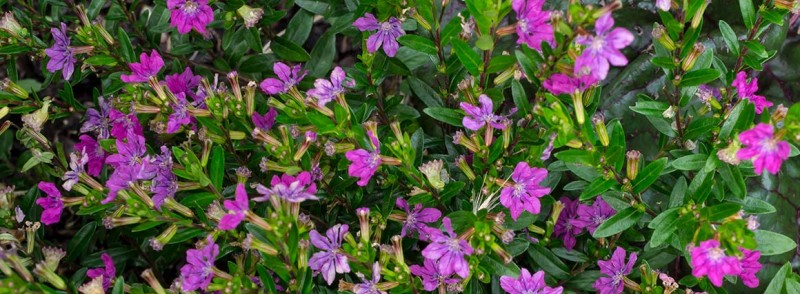
Cuphea hyssopifolia, the false heather, Mexican heather or elfin herb, is a small tropical evergreen sub-shrub belonging to Lythraceae (Loosestrife family). The plant is native to Mexico, Guatemala and Honduras. It has naturalized to Hawaii and is considered weedy there. Apart from false heather it is also known as Hawaiian Heather, Elfin Herb, Elfin Plant, Cuphea, Clammy Cuphea, Corail, Tarweed, Mexican Heather, Heather and Elfin bush. Genus name ‘Cuphea’ comes from the Greek word kyphos meaning curved or humped in probable reference to the shape of its seed capsules. The species epithet ‘hyssopifolia’ refers to the shape of the leaves which are like those of the herb Hyssop. Not a true heather, the leaves resemble to those of Scotch heather (Calluna vulgaris), thus derived its common name false heather. The plant is harvested from the wild for local use as a medicine and insecticide. It is often grown as an ornamental in the tropics – in the temperate zone it can be grown as a summer bedding plant.
Traditional uses and benefits of False Heather
- It is used medicinally in Mexico and in Bangladesh.
- In Brazil, it is used to treat high cholesterol and triglycerides.
- In French Guiana, stem and leaf are macerated in rum and rubbed onto sprains.
- Leaf infusion is used for colds and chills.
- In Bangladesh, it is used as tonic and insect repellent; also used for dermatitis, fever, and cough.
- The leaves and flowers of are used as a tonic and in the treatment of fevers and coughs.
- The plant is a rich source of phenolic compounds which have been shown to have a strong antioxidant activity.
- In town, infusions of the aerial parts of false heather are used for treating stomach disorders.
- Decoction is taken as a remedy for malaria.
- An infusion is used to relieve feverish states or even to calm a cough.
- Flowers are anti-phetic, anti-tussive and balsamic, being very effective for respiratory ailments.
- It is also used as a wound healer, as well as for snake bites.
- False heather is used to treat indigestion, dysentery, wounds, bruises, and muscle pain.
- Plant often used in prevention of organ stones, subsidence of consumption and fever, curing of infections especially with eyes, healing of poisonous bites and stings.
Other Facts
- It is widely grown and sold as an ornamental plant.
- The leaves and flowers of are used as an insecticide.
- Industrial oils made from these fatty acids have a range of uses, including as a de-foaming agent; a booster for soaps and detergents; and in health and beauty products.
- They can also be used in foods, mostly as vegetable shortenings.
Source or Information: https://www.healthbenefitstimes.com/false-heather/
